Tag Archives: fittings
Japanese Samurai Sword Clay Hardened Real Hamon Rosewood Tachi Saya Fittings
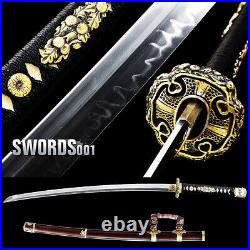
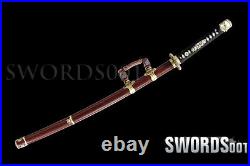
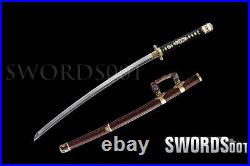

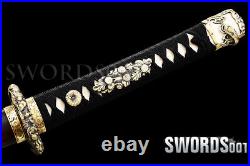
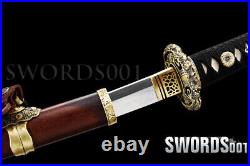
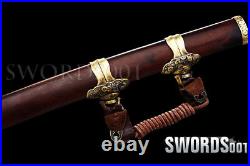
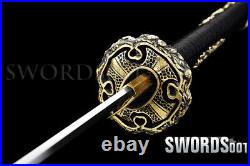
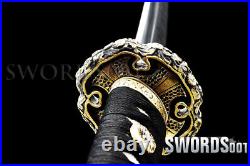
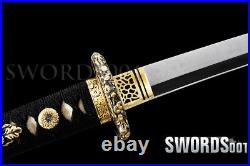



Japanese Samurai Sword Clay Hardened Real Hamon Rosewood Tachi Saya Fittings. Katana (, “sword”): A general term for the traditional sword with a curved blade longer than 60 cm (there is no upper length limit but generally they are shorter than 80 cm), worn with the edge upwards in the sash. Developed from the uchigatana and the sword of the samurai class of the Edo period (1600s to late 19th century). Samurai sword as a weapon is famous for its beautiful shape. They are used as art collection and the symbol of samurai soul. Our sword allows you to make a collection or to send to friends as a present. This katana can be taken apart fully at anytime for maintenance purposes, you can disassemble the sword by taking out the pegs from the handle. OVERALL LENGTH: 103 cm / 40.6 inch. BLADE LENGTH: 70 cm / 27.6 inch. TSUKA LENGTH: 26 cm / 10.24 inch. BLADE WIDTH: 3.2 cm / 1.26 inch. BLADE THICKNESS: 0.7 cm / 0.28. BLADE CRAFT: fully handforged, water quenching, clay tempered. BLADE MATERIAL: 1095 carbon steel. HAMON: real clay tempered line. TSUKA(HANDLE): hard wood core, hineri maki. MEKUGI: 2 bamboo pegs. TSUKA-ITO: black synthetic silk wrapping cord. SAMEGAWA: genuine white rayskin. FUCHI / KASHIRA / MENUKI: brass. TSUBA(HAND GUARD): gold & silver-plated brass. HABAKi & SEPPA: brass. SAYA: rosewood scabbard with Tachi fittings. 1 sword with saya. International Buyers – Please Note. Please contact with us before you leave feedback. We will try our best to solve the problem for you, thank you. Sometimes, you may not get our reply immediately due to the time difference among each country. However, please be assured that we’ll strive to reply you as soon as possible once we got your messages. This item is in the category “Collectibles\Knives, Swords & Blades\Swords & Sabers\Asian\Japanese”. The seller is “moranguoji2015″ and is located in this country: CN. This item can be shipped worldwide.
- Type: katana
- Tang: Full
- Handle Material: Wood
- Blade Material: Carbon Steel
- Theme: Samurai
- Dexterity: Right-Handed
- Edge: Single, Curved
- Handedness: Double-Handed
- Brand: SJ SHI JIAN
- Color: Brown
- Original/Reproduction: Original
- Country/Region of Manufacture: China
- Style: Japanese

Clay Tempered 1095 Carbon Steel Sword Japanese Samurai Katana Brass Fittings
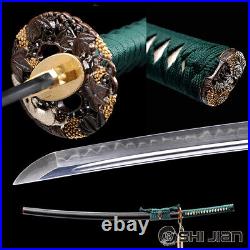
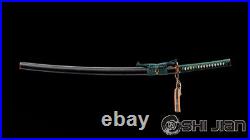


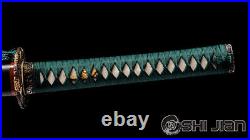

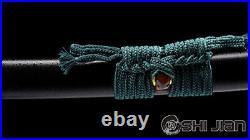
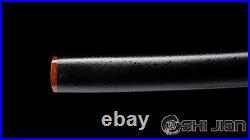

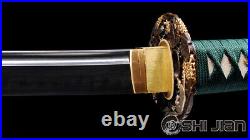
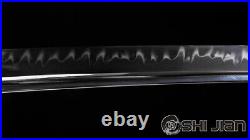
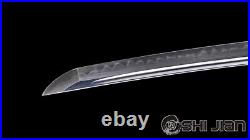

Clay Tempered 1095 Carbon Steel Sword Japanese Samurai Katana Brass Fittings. Samurai katana as a weapon is famous for its beautiful shape. They are used as art collection and the symbol of samurai soul. Our sword allows you to make a collection or to send to friends as a present. This katana can be taken apart fully at anytime for maintenance purposes, you can disassemble the sword by taking out the pegs from the handle. 103 cm / 40.6 inch. 70 cm / 27.6 inch. 26 cm / 10.24 inch. BLADE WIDTH: 3.2 cm / 1.26. BLADE THICKNESS: 0.7 cm / 0.28. BLADE CRAFT: fully handforged and polished through 11 procedures. BLADE MATERIAL: 1095 carbon steel. TSUKA(HANDLE): hard wood core, hineri maki. MEKUGI: 2 bamboo pegs. TSUKA-ITO: dark green synthetic silk cord. SAMEGAWA: white genuine rayskin. FUCHI / KASHIRA: high grade brass, golden chrysanthemum. MENUKI: high grade brass, golden. TSUBA(HAND GUARD): gold & silver plated brass. SEPPA: high quality brass. HABAKi: high quality brass. Sageo: dark green specialized synthetic silk. SAYA: matt black lacquered wooden scabbard with yellow buffalo horn Kurigata Koiguchi Koijiri. 1 sword with saya. Manual measurement error range 1-2 cm. Before being quenched, a special clay mixture can be applied onto the blade to harden the edge and obtain different hardness on the blade. The clay mixture was a special recipe and considered a crucial trade secret, guarded protectively by sword making masters. It would contain such things as feathers, powdered bones, grass, etc. And would be applied to the edge of the blade before being quenched. During quenching, a chemical reaction between the clay mixture and the hot steel occurs during the sudden temperature drop and carbon is fed into the blade in high amounts, creating an extremely tough edge. A clay hardened blade can only be quenched in water, thus increasing the defect rate even more. Another way for clay tempering is to apply clay along the blade but let edge exposed. Thus, while quenching the blade into water, the uncovered edge will cool down suddenly, but the rest of blade will cool down slowly. Such differential temperature change results in the different hardness of the blade. So the edge is tough enough to cut, where the back of blade is soft /flexible enough to absorb the impact during cutting. Such quenching process usually will leave beautiful wavy tempered line on the blade, as known as “hamon” in Japanese swords term. SWORD MOUNTINGS FOR CHOOSING. HOW TO DISASSEMBLE A JP SWORD. If you don’t like the color or the style of the mountings, you can choose different ones from the options below. Is usually a round (or occasionally squareish) guard at the end of the grip of Japanese swords. They contribute to the balance of the sword and to the protection of the hand. The tsuba was mostly meant to be used to prevent the hand from sliding onto the blade during thrusts as opposed to protecting from an opponent’s blade. Tsuka-ito is the wrapping of the tsuka and sageo?? Is a hanging cord that is passed through the hole in the kurigata?? Of a Japanese sword’s saya. Is the ray or shark skin wrapping of the tsuka (handle/hilt). The saya is a wooden scabbard for the blade; traditionally done in lacquered wood. For engraving English words, Chinese characters and Japanese Kanji. For engraving patterns dragon, lion, etc. Swords can be shaped by a variety of metalworking techniques. The primary techniques are forging and stock removal. Forging uses heat to bring the material to a malleable state. The material is then hammered to shape, typically using hammer and anvil together with specialized set and fuller tools depending on the particular technique. Stock removal shapes the sword from prepared stock that is larger in all dimensions than the finished sword by filing, grinding and cutting. After the blade has been shaped, the sword would be quenched. We quench our swords in either water or oil. Water quenching produces a tougher edge which can also be hardened further more using clay. Blades quenched in oil are still considerably hardened and do have superior flexibility compared to a water quenched blade. The more rapidly a blade cools down, the harder it becomes. Thus, when a hot blade enters the water, the water also gains heat and the blade will cool more gradually. Therefore, the first part of the blade that enters the water will be the hardest. Therefore, the technique of quenching was also very important. If a blade has any flaws from forging (air bubbles, ash), it will break immediately during the quenching process. After quenching, the sword will be quite tough and brittle, with little flexibility. To overcome this, the blade would undergo a tempering process. The blade would be reheated to a certain temperature degree then allowed to cool naturally. The blade would be slightly less tough afterward but have a greater degree of flexibility – the art would be to perfectly balance the blade for toughness, sharpness and flexibility. Finishing encompasses polishing, decorating, and crafting and assembling the hilt, guard and sheath. The swordsmith would be most concerned with the state of the blade itself and possibly decorating the blade and preparing the guards and pommel. Other artisans would likely be involved in the work of fashioning the hilt, sheath and other furniture; and in any fine decoration. When the rough blade is completed, the swordsmith turns the blade over to a polisher, whose job it is to refine the shape of a blade and improve its aesthetic value. The polishing process almost always takes longer than even crafting, and a good polish can greatly improve the beauty of a blade, while a bad one can ruin the best of blades. Early polishers used three types of stone, whereas a modern polisher generally uses seven. On high quality blades, only the back of the blade and the adjacent sides, are polished to a mirror-like surface. To bring out the grain and hamon, the center portion of the blade, and the edge are usually given a matte finish. Microscopic scratches in the surface vary, depending on hardness. Smaller but more numerous scratches in the harder areas reflect light differently from the deeper, longer scratches in the softer areas. The harder metal appears more matte than the softer, and the manner in which it scatters light is less affected by the direction of the lighting. After the blade is finished it is passed on to a mountings-maker for fashioning the hilt, sheath and other mountings. International Buyers – Please Note. This item is in the category “Collectibles\Knives, Swords & Blades\Swords & Sabers\Asian\Japanese”. The seller is “yanli22″ and is located in this country: CN. This item can be shipped worldwide.
- Type: Katana
- Handle Material: Cord Wrapped
- Tang: Full
- Dexterity: Right-Handed
- Edge: Single, Curved
- Handedness: Double-Handed
- Country/Region of Manufacture: China
- Theme: Samurai
- Brand: SJ SHI JIAN
- Color: Green
- Blade Material: Carbon Steel
- Original/Reproduction: Original
- Style: Japanese

High Carbon Steel Sharp Sword Japanese Samurai Katana Gold Tachi Saya Fittings
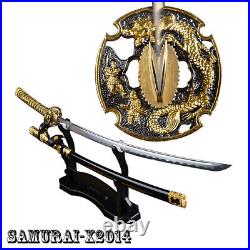
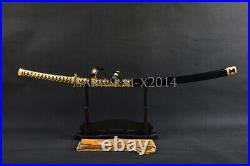
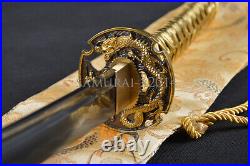


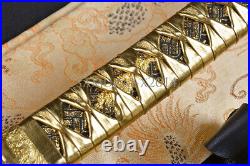
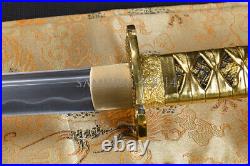
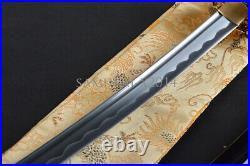
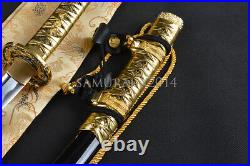

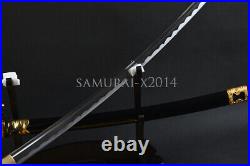
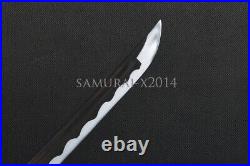

High Carbon Steel Sharp Sword Japanese Samurai Katana Gold Tachi Saya Fittings. Were often forged with different profiles, different blade thicknesses, and varying amounts of grind. The forging of a Japanese blade typically took weeks or even months and was considered a sacred art. As with many complex endeavors, rather than a single craftsman, several artists were involved. There was a smith to forge the rough shape, often a second smith (apprentice) to fold the metal, a specialist polisher (called a togi) as well as the various artisans that made the various fittings used to decorate the finished blade and saya (sheath). It is said that the sharpening and polishing process takes just as long as the forging of the blade itself. After the blade is finished it is passed on to a mountings-maker, or sayashi. The obvious part of the hilt consists of a metal or wooden grip called a tsuka, which can also be used to refer to the entire hilt. The hand guard, or tsuba, on Japanese swords is small and round, made of metal or alloy, and often very ornate. There is a pommel at the base known as a kashira, and there is often a decoration under the braided wrappings called a menuki. A bamboo peg called a mekugi is slipped through the tsuka and through the tang of the blade, using the hole called a mekugi-ana (“peg hole”) drilled in it. This anchors the blade securely into the hilt. To anchor the blade securely into the sheath it will soon have, the blade acquires a collar, or habaki, which extends an inch or so past the hand guard and keeps the blade from rattling. The saya is decorative or battle-worthy sheath. Blade Steel: 1060 High carbon steel. BO-HI: Long HI on each side. Blade Length: 70cm/27.6′. Handle Length: 26cm/10.24′. Overall Length: 103cm/40.6′. Width: 3.2cm/1.25′. Thickness: 0.7cm/0.28′. Tuska: Hard wood wrapped with silk(instead of the rayskin) & synthetic leather ito. Sheath: Lacquered Wood Scabbard, imitative leather ito. Other Fittings: Alloy fuchi/kashira+brass seppa/habaki+alloy menuki. The Habaki (blade collar) is a one piece brass construction. Two Seppas (spacer) secure the Tsuba. Condition: Brandnew, can be disassembled. The stand is only for display, not included in the package. International Buyers – Please Note. Please contact with us before you leave feedback. We will try our best to solve the problem for you, thank you. Sometimes, you may not get our reply immediately due to the time difference among each country. However, please be assured that we’ll strive to reply you as soon as possible once we got your messages. This item is in the category “Collectibles\Knives, Swords & Blades\Swords & Sabers\Asian\Japanese”. The seller is “swords001″ and is located in this country: CN. This item can be shipped worldwide.
- Type: Tachi
- Tang: Full
- Handle Material: Wood
- Blade Material: Carbon Steel
- Theme: Samurai
- Dexterity: Right-Handed
- Edge: Single, Curved
- Handedness: Double-Handed
- Brand: SJ SHI JIAN
- Color: Gold
- Original/Reproduction: Original
- Country/Region of Manufacture: China
- Style: Japanese

